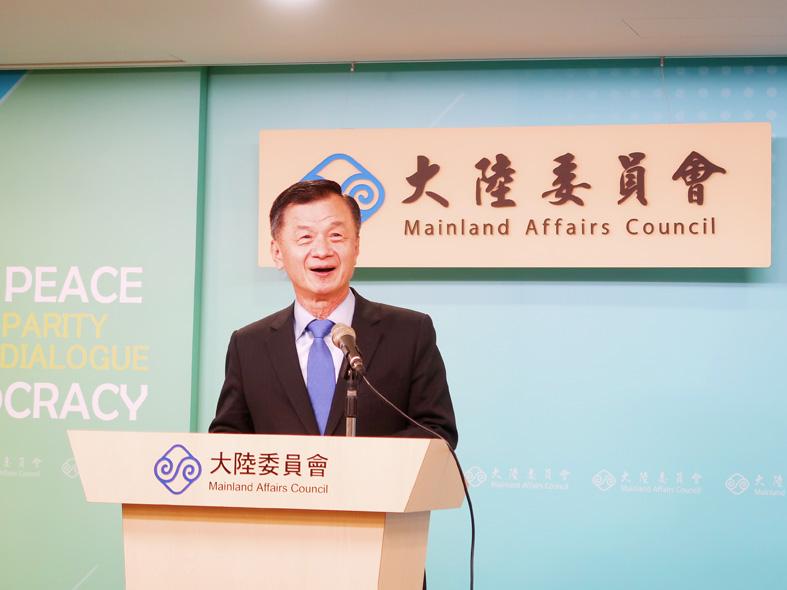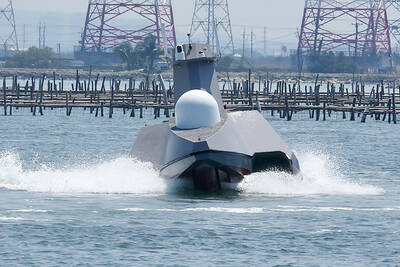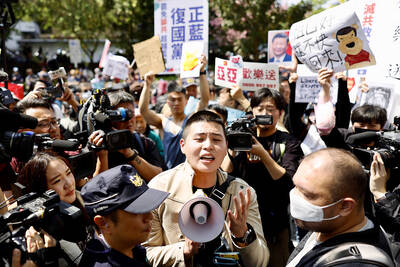Cross-strait relations can hopefully proceed with “constructive ambiguity,” given the right attitude from both sides, Mainland Affairs Council (MAC) Minister Chiu Tai-san (邱太三) said yesterday as he announced rules to allow business travelers from China to visit amid the COVID-19 pandemic.
If cross-strait exchanges must be founded on the premise that one side accepts the other’s framework, “then I think it is an unfair, unjust and unrealistic request,” Chiu told a news conference in Taipei.
Chiu was referring to Beijing’s insistence that Taipei accept its interpretation of the so-called “1992 consensus,” which it reiterated after he vowed to facilitate a thaw in cross-strait ties when he accepted the post last month.

Photo: Chen Yu-fu, Taipei Times
The “1992 consensus” — a term that former MAC chairman Su Chi (蘇起) in 2006 admitted making up in 2000 — refers to a tacit understanding between the Chinese Nationalist Party (KMT) and the Chinese Communist Party that both sides of the Taiwan Strait acknowledge there is “one China,” with each side having its own interpretation of what “China” means.
“I think the two sides can be more friendly and cooperative,” Chiu said. “There is no need to force yourself or others to enter into a set framework.”
“Finding the greatest common denominator” would benefit both sides and elicit the least controversy, he said.
However, whether the two could achieve constructive ambiguity “depends on the wisdom of both sides, and honestly, it also depends on their attitudes,” he said, referring to China.
It is thought to be the first time that a MAC minister has used the phrase “constructive ambiguity,” which has come to define US policy toward Taiwan since the time of former US secretary of state Henry Kissinger.
Addressing Beijing, Chiu made three requests: the cessation of military threats; pragmatic dialogue; and a reciprocal effort toward developing cross-strait exchanges.
He urged Beijing to understand that Taiwan’s systems and values are different from China’s, and to view the development of cross-strait ties in a positive light.
Underlining his intent, Chiu announced an end to a ban on Chinese business travelers after more than a year of COVID-19 travel restrictions.
Chinese businesspeople fulfilling contract obligations, as well as Chinese employed by multinationals slated for transfer, would be permitted entry upon approval by the Ministry of the Interior, he said.
The council made the decision in consultation with the Central Epidemic Command Center (CECC) and other agencies in a bid to facilitate cross-strait economic activity, he said.
Discussions are continuing on whether to resume travel for Chinese with family in Taiwan, as well as on border control adjustments, he said.
However, as the center does not yet list China as a medium-low or low-risk region, Chinese business travelers are not eligible for shortened quarantines, CECC spokesman Chuang Jen-hsiang (莊人祥) said.
Like other travelers, they must provide a negative polymerase chain reaction test conducted within three days of departure for Taiwan, and undergo 14 days of quarantine followed by seven days of self-health management, Chuang said.
Aside from business travelers, Chinese nationals with Taiwanese residency, as well as their spouses and children, can enter Taiwan, in addition to students, and those with imperative family or health reasons.
Additional reporting by CNA

ENDEAVOR MANTA: The ship is programmed to automatically return to its designated home port and would self-destruct if seized by another party The Endeavor Manta, Taiwan’s first military-specification uncrewed surface vehicle (USV) tailor-made to operate in the Taiwan Strait in a bid to bolster the nation’s asymmetric combat capabilities made its first appearance at Kaohsiung’s Singda Harbor yesterday. Taking inspiration from Ukraine’s navy, which is using USVs to force Russia’s Black Sea fleet to take shelter within its own ports, CSBC Taiwan (台灣國際造船) established a research and development unit on USVs last year, CSBC chairman Huang Cheng-hung (黃正弘) said. With the exception of the satellite guidance system and the outboard motors — which were purchased from foreign companies that were not affiliated with Chinese-funded

PERMIT REVOKED: The influencer at a news conference said the National Immigration Agency was infringing on human rights and persecuting Chinese spouses Chinese influencer “Yaya in Taiwan” (亞亞在台灣) yesterday evening voluntarily left Taiwan, despite saying yesterday morning that she had “no intention” of leaving after her residence permit was revoked over her comments on Taiwan being “unified” with China by military force. The Ministry of the Interior yesterday had said that it could forcibly deport the influencer at midnight, but was considering taking a more flexible approach and beginning procedures this morning. The influencer, whose given name is Liu Zhenya (劉振亞), departed on a 8:45pm flight from Taipei International Airport (Songshan airport) to Fuzhou, China. Liu held a news conference at the airport at 7pm,

AIR SUPPORT: The Ministry of National Defense thanked the US for the delivery, adding that it was an indicator of the White House’s commitment to the Taiwan Relations Act Deputy Minister of National Defense Po Horng-huei (柏鴻輝) and Representative to the US Alexander Yui on Friday attended a delivery ceremony for the first of Taiwan’s long-awaited 66 F-16C/D Block 70 jets at a Lockheed Martin Corp factory in Greenville, South Carolina. “We are so proud to be the global home of the F-16 and to support Taiwan’s air defense capabilities,” US Representative William Timmons wrote on X, alongside a photograph of Taiwanese and US officials at the event. The F-16C/D Block 70 jets Taiwan ordered have the same capabilities as aircraft that had been upgraded to F-16Vs. The batch of Lockheed Martin

GRIDLOCK: The National Fire Agency’s Special Search and Rescue team is on standby to travel to the countries to help out with the rescue effort A powerful earthquake rocked Myanmar and neighboring Thailand yesterday, killing at least three people in Bangkok and burying dozens when a high-rise building under construction collapsed. Footage shared on social media from Myanmar’s second-largest city showed widespread destruction, raising fears that many were trapped under the rubble or killed. The magnitude 7.7 earthquake, with an epicenter near Mandalay in Myanmar, struck at midday and was followed by a strong magnitude 6.4 aftershock. The extent of death, injury and destruction — especially in Myanmar, which is embroiled in a civil war and where information is tightly controlled at the best of times —